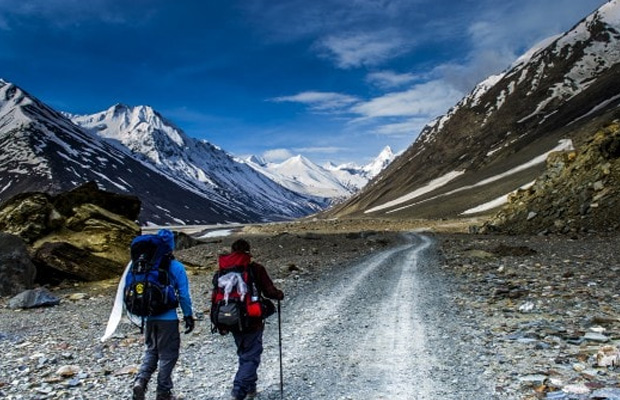
Trekking in the Spiti Valley is a dream come true for adventure lovers, offering an unmatched experience amid the rugged, pristine landscapes of the Himalayas. Located in Himachal Pradesh, Spiti Valley is well known as the “Little Tibet” due to its high-altitude desert terrain, Buddhist monasteries and ancient cultural heritage. With its breathtaking views, isolated villages and challenging trails, trekking in Spiti Valley is an unforgettable journey.
In this article, you will explore what makes trekking in Spiti special, popular treks and essential tips for anyone planning a journey to this magnificent valley.
About Spiti Valley –
The high-altitude Spiti Valley is tucked away between India and Tibet. The valley provides an incredible blend of barren mountains, historic monasteries and blue rivers at elevations between 3,000 and 4,500 meters. The majority of the valley’s residents are Tibetan Buddhists and it is the location of some of India’s oldest monasteries like Tabo Monastery. Remote settlements like Komic, Langza and Dhankar are scattered throughout Spiti’s untamed yet breathtaking scenery. Spiti Valley makes it a more remote and genuine trekking destination in the Himalayas.
Popular treks in Spiti Valley:
Spiti Valley is home to several treks ranging in difficulty from moderate to strenuous. Some of the most popular treks are –
Kaza – Komic – Langza Trek
Duration: 2 to 3 days
The short trek begins from Kaza, the capital of Spiti and goes to the high-altitude villages of Komic and Langza. It is known for its giant Buddha statue and fossil-rich surroundings. The trek offers an ideal introduction to Spiti’s unique topography and allows trekkers to acclimate to the altitude.
Dhankar Lake Trek
Duration: 1 Day
The relatively short trek begins from the ancient Dhankar Monastery and goes up to Dhankar Lake, a hidden gem surrounded by rugged mountains. The trek to the lake is a bit steep, but when you reach the lake, it is surreal and breathtaking. Set against a backdrop of barren peaks, is worth exploring. It’s a great place to hike for those looking to experience Spiti’s natural beauty in a short time.
Pin Parvati Pass Trek
Duration: 9 to 11 days
The challenging trek is a crossover from Kullu Valley into Spiti Valley, travelling the Pin Parvati Pass at an elevation of 5319 meters. The trek passes through dense forests, alpine meadows, glaciers and eventually leading to the barren landscapes of Spiti. The journey offers a dramatic transition from the lush greenery to the arid terrain of Spiti.
Spiti to Chandra Tal Trek
Duration: 4 to 5 days
The trek leads from Spiti Valley to the stunning Chandra Tal or “Moon Lake” which sits at an altitude of 4,300 meters. The lake’s crystal-clear waters are surrounded by towering peaks, making it one of the most beautiful trekking in the region. The trek offers splendid views of snowy mountains and serene landscapes.
Parang La Trek
Duration: 8 to 10 days
The trek connects Spiti Valley with Ladakh, crossing the Parang La Pass at 5600 meters. Famous for its challenging trails, glaciers and river crossings, the Parang La Trek is a test of stamina and endurance. The rewards on this trail are plenty, like majestic mountain views, remote settlements and a glimpse into the nomadic lifestyle of the Changpa tribe.
Important tips for trekking in Spiti Valley:
Acclimatization – Spiti’s high altitudes will lead to altitude sickness, so you can spend at least a couple of days in Kaza or other lower-altitude areas before starting the trek.
Best time to trek – The ideal time for trekking in Spiti is from June to September when the climate is relatively mild and the roads are accessible.
Physical Fitness – Many treks in Spiti are challenging with steep ascents and rough paths. Physical fitness and stamina are important for high-altitude treks.
Packing Essentials – Bring layered clothing, as temperatures can vary significantly between day and night. Essential gear includes a sturdy backpack, trekking poles, high-altitude sleeping bags and a reliable pair of trekking boots.
Permits and documentation – Certain treks, especially those close to the Tibetan border, may require permits. Check with local authorities or your trekking guide to ensure all necessary permits are in place.
Stay hydrated and carry snacks – High altitudes can cause dehydration, so carry sufficient water and stay hydrated.
Respect local culture – Spiti Valley has a deep-rooted Buddhist culture. Dress appropriately, respect local customs and ask for permission before photographing the locals.
Conclusion –
Spiti Valley Trek is a transformative experience, allowing adventurers to explore one of India’s most awe-inspiring and culturally enriched landscapes. Spiti Valley offers a journey into a world that feels timeless and mystical.